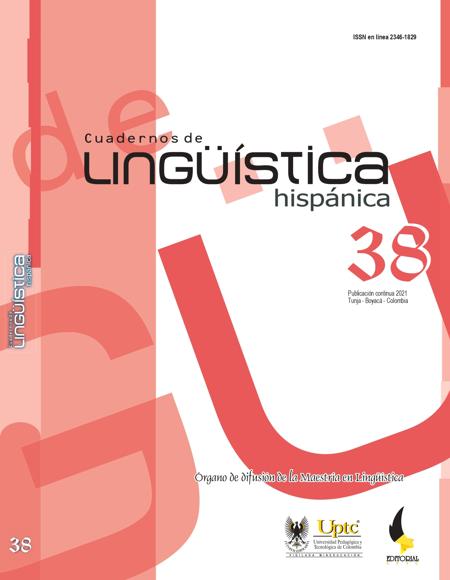Marks of Possession in Wayuunaiki

Abstract
The objective of this paper is to analyze and interpret the morphological marks that refer to possession in the grammatical context of the name; likewise, demonstrate how a nominal possessive structure is built in this language. The analysis of the data collected in the field was done from the perspective of descriptive linguistics (Himmelmann, 1998; Chelliah & De Reuse, 2011), which includes the collection of first-source data, the detection of regular patterns that underlie the functioning of the grammatical aspects studied and their study based on categories and terminology that are widely disseminated in descriptive works. In Wayuunaiki, position marks are distinguished: the inalienable possession marks and the alienable possession marks. To the category of inalienable belong the names that refer to the parts of the human body, the terms of kinship, the parts of the body of animals, the parts of plants, some inanimate names that refer to things closely related to humans. Morphologically, Wayuunaiki treats inalienable and alienable names differently.
Keywords
wayunaiki, posesión, inalienable, alienable, marcas morfológicas, nombre, pronominal
References
- Aikhenvald, A. Y. (2012). Possession and ownership: a cross linguistic perspective. Oxford: Oxford University Press. DOI: https://doi.org/10.1093/acprof:oso/9780199660223.003.0001
- Aikhenvald, A. Y. (2000). Classifiers. A typology of noun categorization devices, Oxford: Oxford University Press.
- Aikhenvald, A. Y. (1999). The arawak language family. The Amazonian languages, 65–106. Dixon R.M.W & A. Y. Aikhenvald (Eds.). Cambridge University Press.
- Bickel, Balthasar, Johanna Nichols (2013) Obligatory Possessive Inflection. In: Dryer, Matthew S. & Haspelmath, Martin (eds.) The World Atlas of Language Structures Online. Leipzig: Max Planck Institute for Evolutionary Anthropology.
- (Available online at http://wals.info/chapter/58, Accessed on 2018-06-07.)
- Chappell, H. & McGregor, W. (1996). Prolegomena to a theory of inalienability. In: Chappell, Hilary & McGregor, William (eds.) The grammar of inalienability, 3-30. Berlin: Mouton de Gruyter. DOI: https://doi.org/10.1515/9783110822137.3
- Chelliah, S. L. & Willem J. de Reuse (2011). Handbook of Descriptive Linguistic Fieldwork. Netherlands: Springer. DOI: https://doi.org/10.1007/978-90-481-9026-3
- Creissels, D. (2006). Syntaxe générale. En: Une introduction typologique. Vol. 1 y 2. Paris: Lavoisier.
- Dahl, Ö. & Koptjevskaja-T. M. (1998). Alienability splits and the grammaticalization of possessive constructions. In: Haukioja, Timo (ed.), Papers from the 16th Scandinavian Conference of Linguistics, 38-49. Turku: University of Turku.
- DANE Censo nacional de Población (2019); resultados preliminares.
- De Carvalho, F. (2016). The diachrony of person-number marking in the Lokono-wayuunaiki subgroup of the Arawak family. Language Sciences (55), 1–15 DOI: https://doi.org/10.1016/j.langsci.2016.02.001
- Dixon, R. M. W., and. Aikhenvald, A. Y. eds. (1999). The Amazonian Languages. (Cambridge Language Surveys.) Cambridge: Cambridge University Press.
- Dryer, Matthew S. (2013b) Coding of Nominal Plurality. In: Dryer, Matthew S. & Haspelmath, Martin (eds.) The World Atlas of Language Structures Online. Leipzig: Max Planck Institute for Evolutionary Anthropology. (Available online at http://wals.info/chapter/57, Accessed on 2018-06-06.)
- Dryer, M. (2007). Noun phrase structure. En: Thimothy Shopen (Ed.). Language Typology and syntactic Description Second edition Volume II: complex Constructions. Cambridge: Cambridge University Press DOI: https://doi.org/10.1017/CBO9780511619434.003
- Heine, B. (1997). Possession: cognitive forces, sources, and grammaticalization. Cambridge: CUP. DOI: https://doi.org/10.1017/CBO9780511581908
- Herslund, M. & Sørensen, F. (eds.) (2001). Dimensions of possession. Amsterdam: Benjamins, 201-225. Instituto Geográfico Agustín Codazzi (1986) La Guajira: aspectos geográficos. Bogotá: IGAC
- Koptjevskaja-., M. (1996). Possessive noun phrases in Maltese: Alienability, iconicity, and grammaticalization. Rivista di Linguistica 8.(1), 245-274.
- Lehmann, Christian. (1999). Possession in Yucatec Maya: Structures – functions – typology. Munich: Lincom Europa.
- Mansen, R. y Captain D. (2000) El idioma wayuu (o guajiro. María Stella González de Pérez y Mª L. Rodríguez de Montes (eds.) Lenguas indígenas de Colombia: una visión descriptiva: 795-810. Bogotá: Instituto Caro y Cuervo.
- Mansen, R. y Mansen, K. (1984). Aprendamos Guajiro. Gramática Pedagógica de Guajiro. Editorial Townsend, Bogotá, Colombia.
- McKay, G. R. (1996). Body parts, possession marking and nominal classes in Mosel, Ulrike. 2001. Linguistic Fieldwork. In International Encyclopedia of the Social and Behavioral Sciences, Vol. 13, ed. by Niel J. Smelser and Paul B. Baties, 8906–8910. DOI: https://doi.org/10.1016/B0-08-043076-7/03041-2
- Nichols, J. & Bickel, Balthasar. (2005). Possessive classification In: WALS, 242-245.
- Nichols, J. (1988). On alienable and inalienable possession. In: Shipley, William. (ed.) In honor of Mary Haas. Berlin: Mouton de Gruyter, 475-521. Noonan, DOI: https://doi.org/10.1515/9783110852387.557
- Olza, J. y Jusayú, M. A. (2012). Gramática de la lengua Guajira (morfosintaxis) 3ra edición modificas y aumentada. Universidad Católica Andrés Bello. Caracas: Montalbán La Vega.
- Ramírez, R. (1995). Morfología del verbo en Wayunaiki. Tesis de maestría en Etnolingüística. Universidad de los Andes. Bogotá
- Velazquez-Castillo, M.. (1996). The grammar of possession. Inalienability, incorporationand possessor ascension in Guaraní. Amsterdam: John Benjamins DOI: https://doi.org/10.1075/slcs.33
- Fishman, J. (1979). Sociología del lenguaje Madrid: Cátedra.
- Instituto Geográfico Agustín Codazzi (1986) La Guajira: aspectos geográficos. Bogotá: IGAC